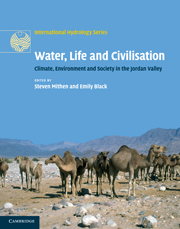Book contents
- Frontmatter
- Contents
- List of figures
- List of tables
- List of contributors
- Acknowledgements
- 1 Introduction: an interdisciplinary approach to Water, Life and Civilisation
- Part I Past, present and future climate
- Part II The palaeoenvironmental record
- Part III Hydrological studies of the Jordan Valley
- Part IV Human settlement, climate change, hydrology and water management
- Part V Palaeoeconomies and developing archaeological methodologies
- 20 The reconstruction of diet and environment in ancient Jordan by carbon and nitrogen stable isotope analysis of human and animal remains
- 21 Irrigation and phytolith formation: an experimental study
- 22 An investigation into the archaeological application of carbon stable isotope analysis used to establish crop water availability: solutions and ways forward
- 23 Past plant use in Jordan as revealed by archaeological and ethnoarchaeological phytolith signatures
- Part VI Society, economy and water today
- Part VII Conclusions
- Index
- Plate section
- References
21 - Irrigation and phytolith formation: an experimental study
from Part V - Palaeoeconomies and developing archaeological methodologies
Published online by Cambridge University Press: 26 April 2011
- Frontmatter
- Contents
- List of figures
- List of tables
- List of contributors
- Acknowledgements
- 1 Introduction: an interdisciplinary approach to Water, Life and Civilisation
- Part I Past, present and future climate
- Part II The palaeoenvironmental record
- Part III Hydrological studies of the Jordan Valley
- Part IV Human settlement, climate change, hydrology and water management
- Part V Palaeoeconomies and developing archaeological methodologies
- 20 The reconstruction of diet and environment in ancient Jordan by carbon and nitrogen stable isotope analysis of human and animal remains
- 21 Irrigation and phytolith formation: an experimental study
- 22 An investigation into the archaeological application of carbon stable isotope analysis used to establish crop water availability: solutions and ways forward
- 23 Past plant use in Jordan as revealed by archaeological and ethnoarchaeological phytolith signatures
- Part VI Society, economy and water today
- Part VII Conclusions
- Index
- Plate section
- References
Summary
ABSTRACT
It has been proposed that phytoliths from archaeological sites can be indicators of water availability and hence inform about past agricultural practices (Rosen and Weiner, 1994; Madella et al., 2009). Rosen and Weiner (1994) found that the number of conjoined phytoliths from cereal husks increased with irrigation while Madella et al. (2009) demonstrated that the ratio of long-celled phytoliths to short-celled phytoliths increased with irrigation. In order to further explore these hypotheses, wheat and barley were experimentally grown from 2005 to 2008 in three different crop growing stations in Jordan. Four different irrigation regimes were initially employed: 0% (rainfall only), 80%, 100% and 120% of the optimum crop water requirements, with a 40% plot being added in the second and third growing seasons. Each plot measured 5 m × 5 m and a drip irrigation system was used. Environmental variables were measured on a daily basis, and soil and water samples were taken and analysed at the University of Reading. Phytoliths from the husks of these experimentally grown plants were extracted using the dry ashing method. Results demonstrate that although the number of conjoined cells increases with irrigation, there were considerable inter-site and inter-year differences suggesting that environmental variables other than water availability affect phytolith uptake and deposition. Furthermore, analytical experiments demonstrated that conjoined phytoliths are subject to change or breakage by external factors, making this methodology problematic to apply to archaeological phytolith assemblages that have an unknown taphonomic history. […]
- Type
- Chapter
- Information
- Water, Life and CivilisationClimate, Environment and Society in the Jordan Valley, pp. 347 - 372Publisher: Cambridge University PressPrint publication year: 2011
References
- 21
- Cited by

